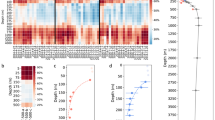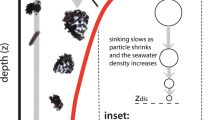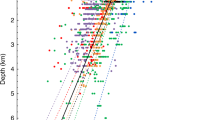Abstract
The flux of particulate matter through the oceanic water column is a primary component in elemental cycling and is generally perceived as being in one direction: downward1, 2. The organic matter constituting these particles is produced through photosynthesis in surface waters and either sinks directly as phytoplankton and products3, 4 or undergoes various trophic transformations through the water column. A large proportion of the particulate organic matter produced in surface waters is regenerated in the euphotic zone5–7. A fraction of this organic matter, however, leaves the surface waters and settles through the water column, generally decreasing in quantity and changing in quality with increasing distance from the surface8–11. Although the net transport of organic matter must be downward to fuel the lower portions of the water column, there is also an upward component to transport. Positively buoyant particles, including lipid-rich eggs, larvae and, possibly, carcasses of deep-sea animals are examples of particles which undergo upward transport12–13. A previous attempt to quantify the upward mass flux indicated rates of 1–4% of the downward mass flux14. Here we report the first evidence that there is a significant upward flux of particulate organic matter, up to 66.7% of the concurrently measured downward flux, at two stations in the deep North Pacific. Given this magnitude, the previously ignored upward flux of such organic matter must be considered in models of carbon and nitrogen cycling in the open ocean.
This is a preview of subscription content, access via your institution
Access options
Subscribe to this journal
Receive 51 print issues and online access
$199.00 per year
only $3.90 per issue
Buy this article
- Purchase on Springer Link
- Instant access to full article PDF
Prices may be subject to local taxes which are calculated during checkout
Similar content being viewed by others
References
Dymond, J. & Lyle, M. Limnol. Oceanogr. 30, 699–712 (1985).
Pace, M. L. et al. Nature 325, 803–804 (1987).
Bienfang, P. K. Mar. Biol. 61, 69–77 (1980).
Zeitschel, B. Proc. R. Soc. Edin. 88B, 207–220 (1986).
Eppley, R. W. & Peterson, B. J. Nature 282, 677–680 (1979).
Baker, E. T. et al. Estuar. Coastal Shelf Sci. 21, 859–877 (1985).
Gardner, W. D. et al. Mar. Geol. 65, 199–242 (1985).
Knauer, G. A. & Martin, J. H. Limnol. Oceanogr. 26, 181–186 (1981).
Lee, C. & Cronin, C. J. Mar. Res. 40, 227–251 (1982).
Lorenzen, C. J. et al. Deep-Sea Res. 30, 639–643 (1983).
Matsueda, H. & Handa, N. Mar. Chem. 20, 179–195 (1986).
Yayanos, A. A. & Nevenzel, J. C. Naturwissenschaften 65, 255–256 (1978).
Robison, B. H. & Lancraft, T. M. Naturwissenschaften 71, 322–323 (1984).
Simoneit, B. R. T. et al. Naturwissenschaften 73, 322–325 (1986).
Smith, K. L. Jr. Limnol. Oceanogr. 32, 201–220 (1987).
Brinton, E. J. Crust. Biol. 7, 636–666 (1987).
Nemoto, T. et al. Bull. Plankt. Soc. Jap. 24, 36–43 (1977).
Mauchline, J. & Fisher, L. R. Adv. Mar. Biol. 7, 1–454 (1969).
Honjo, S. J. Mar. Res. 38, 53–97 (1980).
Tsunogai, S. & Noriki, S. Deep-Sea Res. 34, 755–767 (1987).
Mauchline, J. Mar. Biol. 90, 19–26 (1985).
Merrett, R. Deep-Sea Res. 25, 147–160 (1978).
Marshall, N. B. Developments in Deep-Sea Biology (Blandford, Poole, 1979).
Tyler, P. A. & Gage, J. D. Deep-Sea Res. 31, 387–402 (1984).
Colman, J. G. et al. J. Mar. Biol. Ass. U.K. 66, 951–965 (1986).
Killingley, J. S. & Rex, M. A. Deep-Sea Res. 32, 809–818 (1985).
Bruland, K. W. et al. Earth planet. Sci. Lett. 53, 400–408 (1981).
Conover, W. J. Practical Nonparametric Statistics (Wiley, New York, 1980).
Gardner, W. D. J. Mar. Res. 38, 17–39 (1980).
Smith Jr, K. L. Deep-Sea Res. 36 (in the press).
Knauer, G. A. et al. J. Mar. Res. 42, 445–462 (1984).
Williams, P. M. & Druffel, E. R. M. Oceanography 1, 14–17 (1988).
Author information
Authors and Affiliations
Rights and permissions
About this article
Cite this article
Smith, K., Williams, P. & Druffel, E. Upward fluxes of particulate organic matter in the deep North Pacific. Nature 337, 724–726 (1989). https://doi.org/10.1038/337724a0
Received:
Accepted:
Issue Date:
DOI: https://doi.org/10.1038/337724a0
This article is cited by
-
Production and transport of methane in oceanic particulate organic matter
Nature (1994)
-
Interfacial feeding behavior and particle flow patterns ofAnopheles quadrimaculatus larvae (Diptera: Culicidae)
Journal of Insect Behavior (1992)
-
Ascending and descending fluxes of lipid compounds in North Atlantic and North Pacific abyssal waters
Nature (1990)
Comments
By submitting a comment you agree to abide by our Terms and Community Guidelines. If you find something abusive or that does not comply with our terms or guidelines please flag it as inappropriate.



